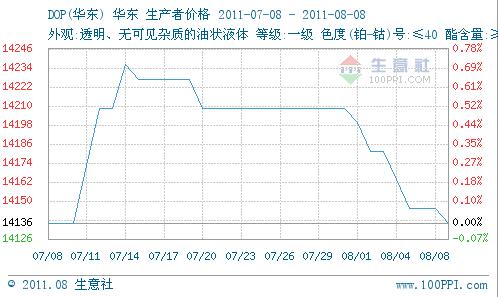 According to statistics from the business community’s mass list, after the DOP market rose slightly in July, its upward trend has not been able to continue in August. Just after entering the month of August, the DOP market has fallen slightly in the midst of weaker, weaker and lighter prices. At present, there are few imported goods in the Zhangjiagang area in eastern China, and the quotation is around 13,900 yuan/ton, the domestic quotation is around 13,800 yuan/ton, and the actual negotiation price is around 50-100 yuan/ton, and the transaction is less heard. The market price of DOP in southern China is 14,000- 14100 yuan / ton near the tank delivery, some lower than 100 yuan / ton, poor turnover; North China DOP market part of the wait and see, the mainstream offer temporarily stable at 13900-14000 yuan / ton, around the low in Shandong, Hebei Tianjin slightly High, poor delivery.
According to statistics from the business community’s mass list, after the DOP market rose slightly in July, its upward trend has not been able to continue in August. Just after entering the month of August, the DOP market has fallen slightly in the midst of weaker, weaker and lighter prices. At present, there are few imported goods in the Zhangjiagang area in eastern China, and the quotation is around 13,900 yuan/ton, the domestic quotation is around 13,800 yuan/ton, and the actual negotiation price is around 50-100 yuan/ton, and the transaction is less heard. The market price of DOP in southern China is 14,000- 14100 yuan / ton near the tank delivery, some lower than 100 yuan / ton, poor turnover; North China DOP market part of the wait and see, the mainstream offer temporarily stable at 13900-14000 yuan / ton, around the low in Shandong, Hebei Tianjin slightly High, poor delivery. What are the influencing factors in the current domestic DOP market? Please analyze the following points:
First, the DOP market is bearish. Since August, as of yesterday (August 8th), international crude oil prices have plummeted by more than 6%. The New York Mercantile Exchange's September delivery of light crude oil prices plummeted by 5.57 U.S. dollars per barrel. USD 81.31, a decrease of 6.41%. Confidence in the industry was frustrated and the market was inquired.
Secondly, the main raw material octanol was affected by the collapse of crude oil, and the market sentiment was light. Since August, the octanol factory has been reduced by nearly 700-800 yuan/ton, the other raw material, phthalic anhydride, has stabilized at a high level, and the cost of DOP market support has weakened. The weakness was weak, trading was dismal, and the market was in a bad mood. The DOP price gradually dropped slightly.
Third, the adverse effects of the international economic situation have expanded. On the 8th, the US Congress announced important non-agricultural employment data. The market generally has pessimistic expectations. Greece's debt problem has not yet been resolved. Italy and Spain's debt problems have begun to emerge, and the European debt crisis has spread further. Yesterday, the financial market started ahead of schedule. The financial markets in Europe and America collapsed and the stock market plummeted. While the US dollar represented a hedging property, the US dollar index rose sharply, and international crude oil and other commodity prices fell sharply.
Fourth, domestic monetary tightening policies are difficult to loosen in the short term, and SME financing is difficult. In addition, the downstream terminal factories have low start-ups due to low orders and limited power supply, and have limited purchases of raw materials, DOP, and have gradually reduced the market price, while shipments have not seen any improvement. Most of the domestic DOP's main plants have low start-ups, some of them have been shut down, and DOP inventory is small.
Under the current market conditions, where should DOP market go? Immediately after the beginning of autumn, the DOP market was chilly in August. Both upstream and downstream support were weak, and the DOP market was bearish. Zou Xiying, an analyst at Business Social Chemicals, believes that the domestic DOP market outlook will be weak and the market will not be optimistic.
The business community rankings were formally launched on August 2, 2011. They can publish weekly, monthly, quarterly, semi-annual, and annual lists for different audiences, covering energy, chemicals, rubber, textiles, steel, nonferrous metals, etc. Building materials, agriculture and vice-eight industries, more than 200 bulk products.